P1: Types of Entrepreneurial Ventures and typology of Entrepreneurship
VerifiedAdded on 2021/02/19
|15
|3926
|27
AI Summary
Contribute Materials
Your contribution can guide someone’s learning journey. Share your
documents today.

Entrepreneurship and
Small Business
Small Business
Secure Best Marks with AI Grader
Need help grading? Try our AI Grader for instant feedback on your assignments.
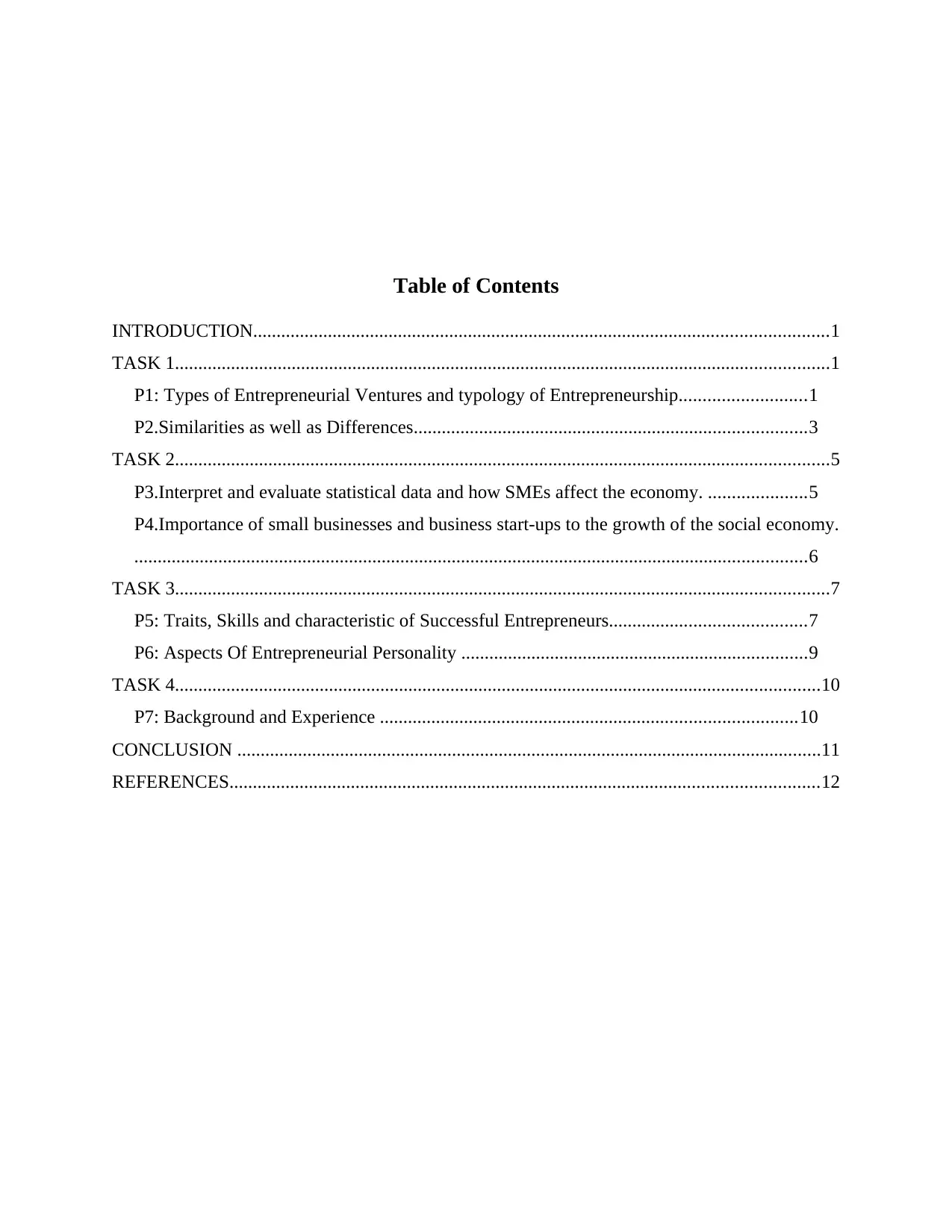
Table of Contents
INTRODUCTION...........................................................................................................................1
TASK 1............................................................................................................................................1
P1: Types of Entrepreneurial Ventures and typology of Entrepreneurship...........................1
P2.Similarities as well as Differences....................................................................................3
TASK 2............................................................................................................................................5
P3.Interpret and evaluate statistical data and how SMEs affect the economy. .....................5
P4.Importance of small businesses and business start-ups to the growth of the social economy.
................................................................................................................................................6
TASK 3............................................................................................................................................7
P5: Traits, Skills and characteristic of Successful Entrepreneurs..........................................7
P6: Aspects Of Entrepreneurial Personality ..........................................................................9
TASK 4..........................................................................................................................................10
P7: Background and Experience .........................................................................................10
CONCLUSION .............................................................................................................................11
REFERENCES..............................................................................................................................12
INTRODUCTION...........................................................................................................................1
TASK 1............................................................................................................................................1
P1: Types of Entrepreneurial Ventures and typology of Entrepreneurship...........................1
P2.Similarities as well as Differences....................................................................................3
TASK 2............................................................................................................................................5
P3.Interpret and evaluate statistical data and how SMEs affect the economy. .....................5
P4.Importance of small businesses and business start-ups to the growth of the social economy.
................................................................................................................................................6
TASK 3............................................................................................................................................7
P5: Traits, Skills and characteristic of Successful Entrepreneurs..........................................7
P6: Aspects Of Entrepreneurial Personality ..........................................................................9
TASK 4..........................................................................................................................................10
P7: Background and Experience .........................................................................................10
CONCLUSION .............................................................................................................................11
REFERENCES..............................................................................................................................12
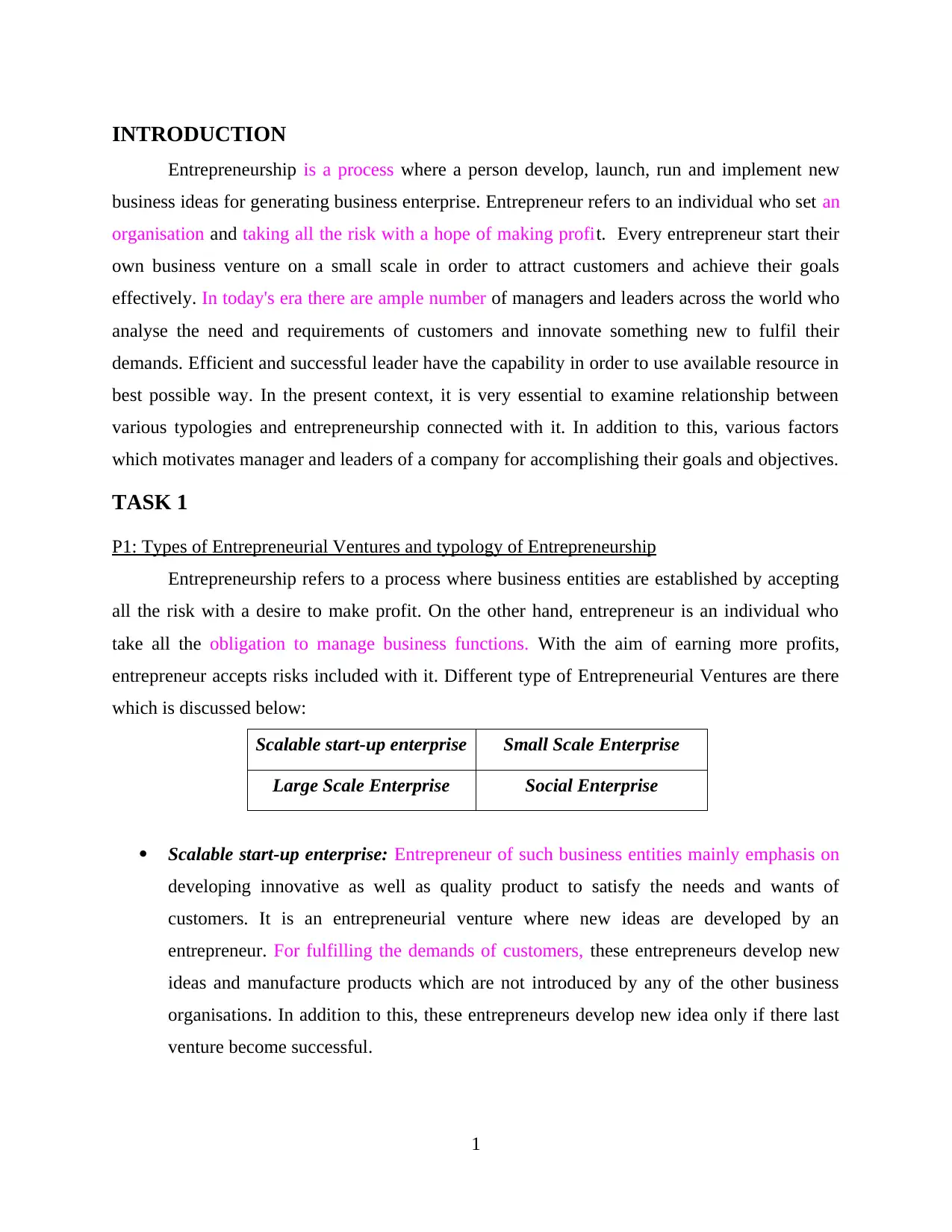
INTRODUCTION
Entrepreneurship is a process where a person develop, launch, run and implement new
business ideas for generating business enterprise. Entrepreneur refers to an individual who set an
organisation and taking all the risk with a hope of making profit. Every entrepreneur start their
own business venture on a small scale in order to attract customers and achieve their goals
effectively. In today's era there are ample number of managers and leaders across the world who
analyse the need and requirements of customers and innovate something new to fulfil their
demands. Efficient and successful leader have the capability in order to use available resource in
best possible way. In the present context, it is very essential to examine relationship between
various typologies and entrepreneurship connected with it. In addition to this, various factors
which motivates manager and leaders of a company for accomplishing their goals and objectives.
TASK 1
P1: Types of Entrepreneurial Ventures and typology of Entrepreneurship
Entrepreneurship refers to a process where business entities are established by accepting
all the risk with a desire to make profit. On the other hand, entrepreneur is an individual who
take all the obligation to manage business functions. With the aim of earning more profits,
entrepreneur accepts risks included with it. Different type of Entrepreneurial Ventures are there
which is discussed below:
Scalable start-up enterprise Small Scale Enterprise
Large Scale Enterprise Social Enterprise
Scalable start-up enterprise: Entrepreneur of such business entities mainly emphasis on
developing innovative as well as quality product to satisfy the needs and wants of
customers. It is an entrepreneurial venture where new ideas are developed by an
entrepreneur. For fulfilling the demands of customers, these entrepreneurs develop new
ideas and manufacture products which are not introduced by any of the other business
organisations. In addition to this, these entrepreneurs develop new idea only if there last
venture become successful.
1
Entrepreneurship is a process where a person develop, launch, run and implement new
business ideas for generating business enterprise. Entrepreneur refers to an individual who set an
organisation and taking all the risk with a hope of making profit. Every entrepreneur start their
own business venture on a small scale in order to attract customers and achieve their goals
effectively. In today's era there are ample number of managers and leaders across the world who
analyse the need and requirements of customers and innovate something new to fulfil their
demands. Efficient and successful leader have the capability in order to use available resource in
best possible way. In the present context, it is very essential to examine relationship between
various typologies and entrepreneurship connected with it. In addition to this, various factors
which motivates manager and leaders of a company for accomplishing their goals and objectives.
TASK 1
P1: Types of Entrepreneurial Ventures and typology of Entrepreneurship
Entrepreneurship refers to a process where business entities are established by accepting
all the risk with a desire to make profit. On the other hand, entrepreneur is an individual who
take all the obligation to manage business functions. With the aim of earning more profits,
entrepreneur accepts risks included with it. Different type of Entrepreneurial Ventures are there
which is discussed below:
Scalable start-up enterprise Small Scale Enterprise
Large Scale Enterprise Social Enterprise
Scalable start-up enterprise: Entrepreneur of such business entities mainly emphasis on
developing innovative as well as quality product to satisfy the needs and wants of
customers. It is an entrepreneurial venture where new ideas are developed by an
entrepreneur. For fulfilling the demands of customers, these entrepreneurs develop new
ideas and manufacture products which are not introduced by any of the other business
organisations. In addition to this, these entrepreneurs develop new idea only if there last
venture become successful.
1
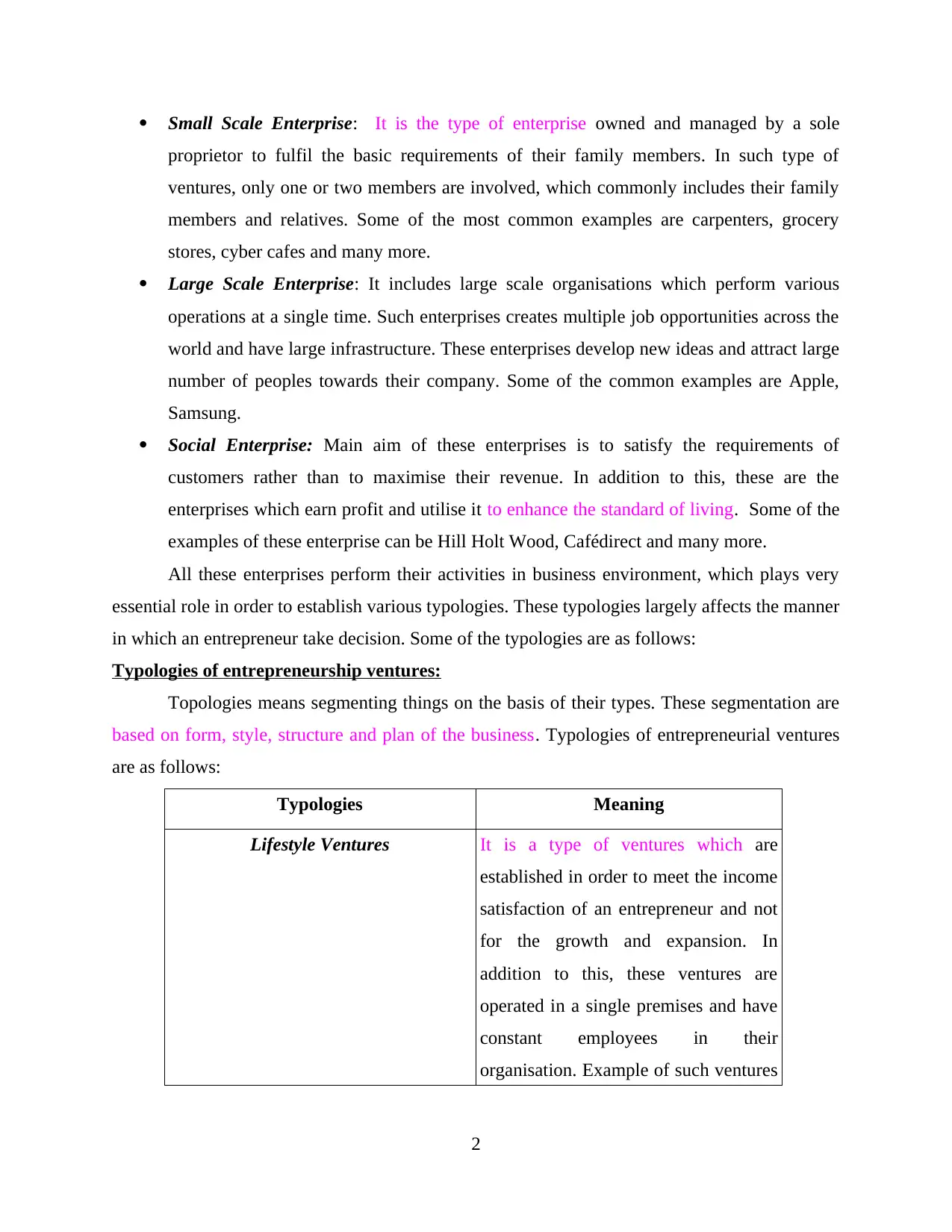
Small Scale Enterprise: It is the type of enterprise owned and managed by a sole
proprietor to fulfil the basic requirements of their family members. In such type of
ventures, only one or two members are involved, which commonly includes their family
members and relatives. Some of the most common examples are carpenters, grocery
stores, cyber cafes and many more.
Large Scale Enterprise: It includes large scale organisations which perform various
operations at a single time. Such enterprises creates multiple job opportunities across the
world and have large infrastructure. These enterprises develop new ideas and attract large
number of peoples towards their company. Some of the common examples are Apple,
Samsung.
Social Enterprise: Main aim of these enterprises is to satisfy the requirements of
customers rather than to maximise their revenue. In addition to this, these are the
enterprises which earn profit and utilise it to enhance the standard of living. Some of the
examples of these enterprise can be Hill Holt Wood, Cafédirect and many more.
All these enterprises perform their activities in business environment, which plays very
essential role in order to establish various typologies. These typologies largely affects the manner
in which an entrepreneur take decision. Some of the typologies are as follows:
Typologies of entrepreneurship ventures:
Topologies means segmenting things on the basis of their types. These segmentation are
based on form, style, structure and plan of the business. Typologies of entrepreneurial ventures
are as follows:
Typologies Meaning
Lifestyle Ventures It is a type of ventures which are
established in order to meet the income
satisfaction of an entrepreneur and not
for the growth and expansion. In
addition to this, these ventures are
operated in a single premises and have
constant employees in their
organisation. Example of such ventures
2
proprietor to fulfil the basic requirements of their family members. In such type of
ventures, only one or two members are involved, which commonly includes their family
members and relatives. Some of the most common examples are carpenters, grocery
stores, cyber cafes and many more.
Large Scale Enterprise: It includes large scale organisations which perform various
operations at a single time. Such enterprises creates multiple job opportunities across the
world and have large infrastructure. These enterprises develop new ideas and attract large
number of peoples towards their company. Some of the common examples are Apple,
Samsung.
Social Enterprise: Main aim of these enterprises is to satisfy the requirements of
customers rather than to maximise their revenue. In addition to this, these are the
enterprises which earn profit and utilise it to enhance the standard of living. Some of the
examples of these enterprise can be Hill Holt Wood, Cafédirect and many more.
All these enterprises perform their activities in business environment, which plays very
essential role in order to establish various typologies. These typologies largely affects the manner
in which an entrepreneur take decision. Some of the typologies are as follows:
Typologies of entrepreneurship ventures:
Topologies means segmenting things on the basis of their types. These segmentation are
based on form, style, structure and plan of the business. Typologies of entrepreneurial ventures
are as follows:
Typologies Meaning
Lifestyle Ventures It is a type of ventures which are
established in order to meet the income
satisfaction of an entrepreneur and not
for the growth and expansion. In
addition to this, these ventures are
operated in a single premises and have
constant employees in their
organisation. Example of such ventures
2
Paraphrase This Document
Need a fresh take? Get an instant paraphrase of this document with our AI Paraphraser
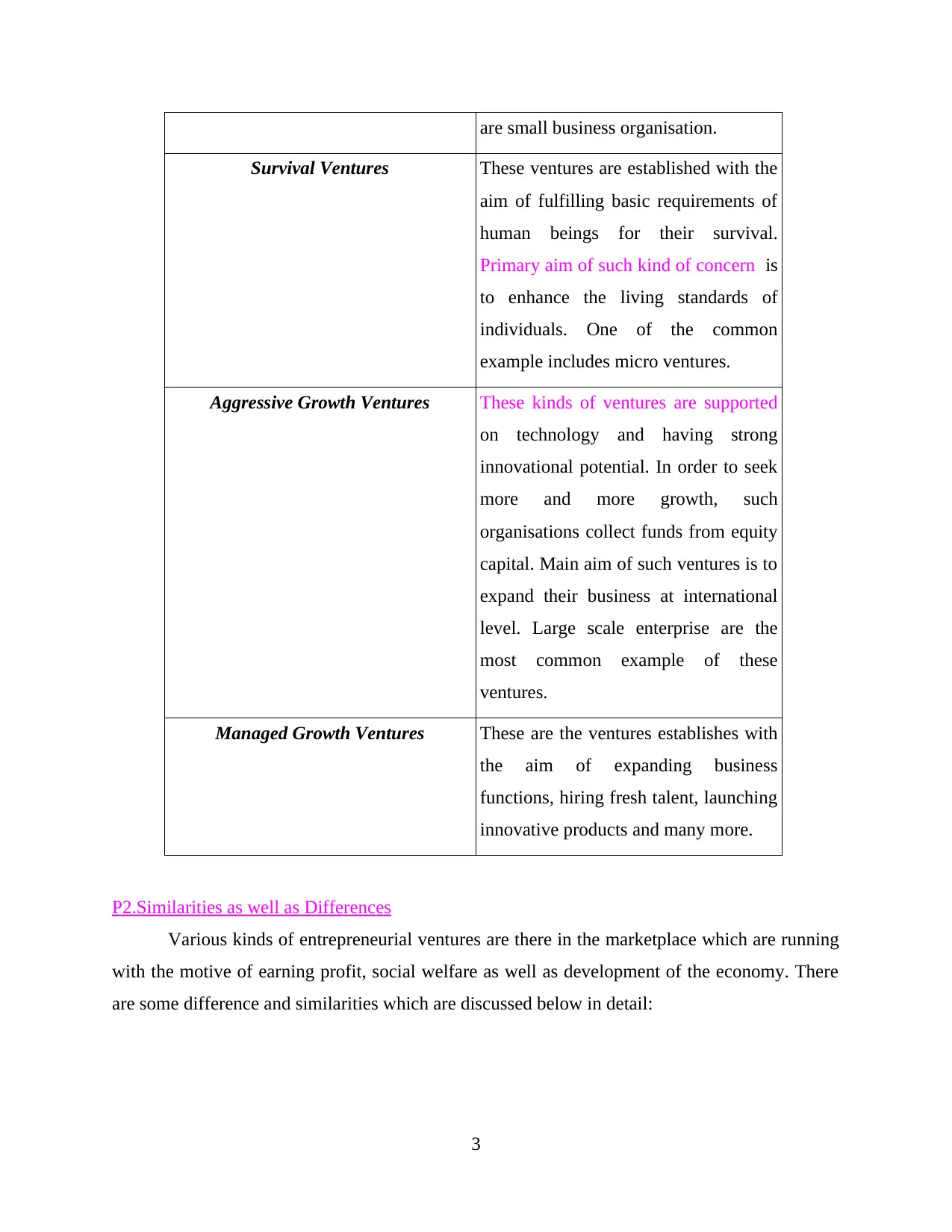
are small business organisation.
Survival Ventures These ventures are established with the
aim of fulfilling basic requirements of
human beings for their survival.
Primary aim of such kind of concern is
to enhance the living standards of
individuals. One of the common
example includes micro ventures.
Aggressive Growth Ventures These kinds of ventures are supported
on technology and having strong
innovational potential. In order to seek
more and more growth, such
organisations collect funds from equity
capital. Main aim of such ventures is to
expand their business at international
level. Large scale enterprise are the
most common example of these
ventures.
Managed Growth Ventures These are the ventures establishes with
the aim of expanding business
functions, hiring fresh talent, launching
innovative products and many more.
P2.Similarities as well as Differences
Various kinds of entrepreneurial ventures are there in the marketplace which are running
with the motive of earning profit, social welfare as well as development of the economy. There
are some difference and similarities which are discussed below in detail:
3
Survival Ventures These ventures are established with the
aim of fulfilling basic requirements of
human beings for their survival.
Primary aim of such kind of concern is
to enhance the living standards of
individuals. One of the common
example includes micro ventures.
Aggressive Growth Ventures These kinds of ventures are supported
on technology and having strong
innovational potential. In order to seek
more and more growth, such
organisations collect funds from equity
capital. Main aim of such ventures is to
expand their business at international
level. Large scale enterprise are the
most common example of these
ventures.
Managed Growth Ventures These are the ventures establishes with
the aim of expanding business
functions, hiring fresh talent, launching
innovative products and many more.
P2.Similarities as well as Differences
Various kinds of entrepreneurial ventures are there in the marketplace which are running
with the motive of earning profit, social welfare as well as development of the economy. There
are some difference and similarities which are discussed below in detail:
3
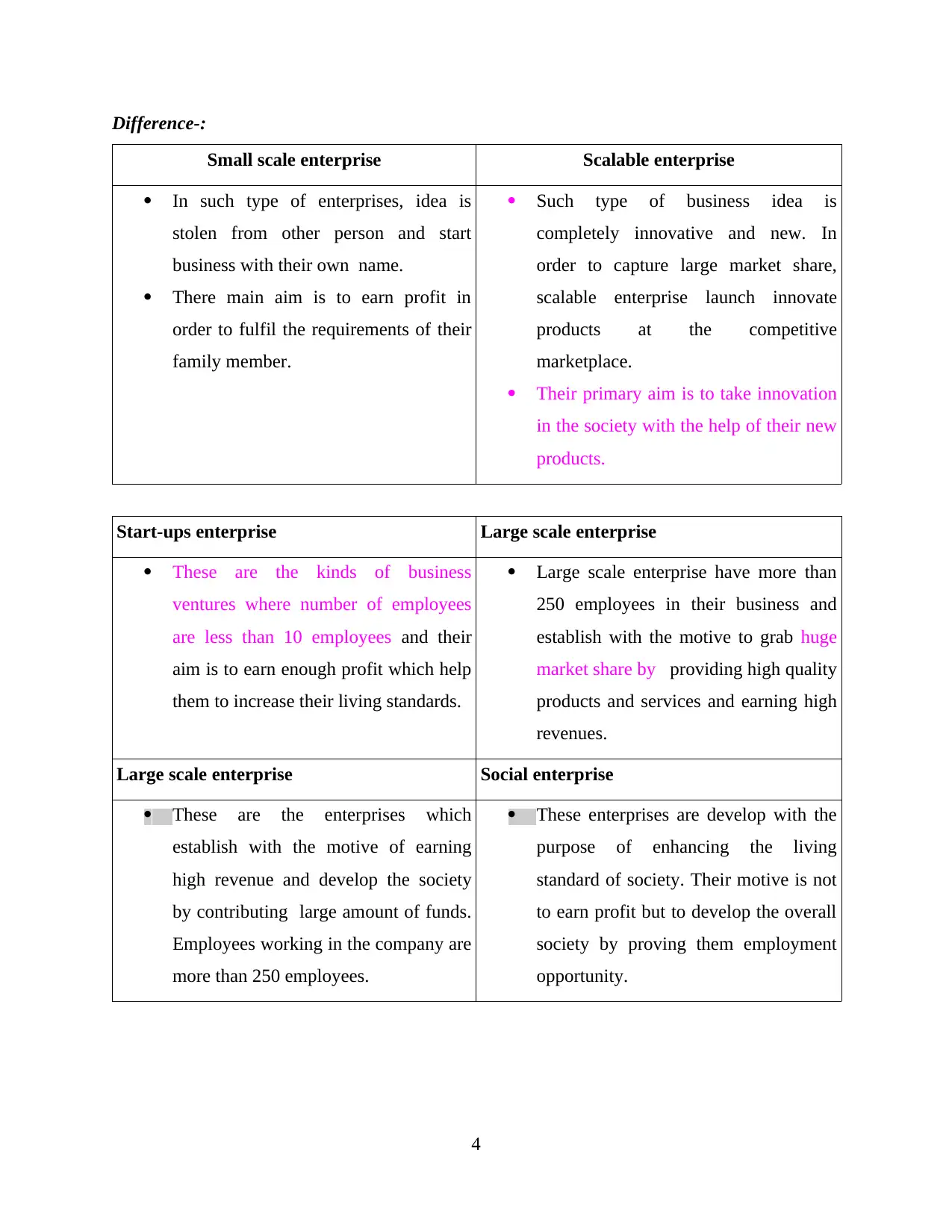
Difference-:
Small scale enterprise Scalable enterprise
In such type of enterprises, idea is
stolen from other person and start
business with their own name.
There main aim is to earn profit in
order to fulfil the requirements of their
family member.
Such type of business idea is
completely innovative and new. In
order to capture large market share,
scalable enterprise launch innovate
products at the competitive
marketplace.
Their primary aim is to take innovation
in the society with the help of their new
products.
Start-ups enterprise Large scale enterprise
These are the kinds of business
ventures where number of employees
are less than 10 employees and their
aim is to earn enough profit which help
them to increase their living standards.
Large scale enterprise have more than
250 employees in their business and
establish with the motive to grab huge
market share by providing high quality
products and services and earning high
revenues.
Large scale enterprise Social enterprise
These are the enterprises which
establish with the motive of earning
high revenue and develop the society
by contributing large amount of funds.
Employees working in the company are
more than 250 employees.
These enterprises are develop with the
purpose of enhancing the living
standard of society. Their motive is not
to earn profit but to develop the overall
society by proving them employment
opportunity.
4
Small scale enterprise Scalable enterprise
In such type of enterprises, idea is
stolen from other person and start
business with their own name.
There main aim is to earn profit in
order to fulfil the requirements of their
family member.
Such type of business idea is
completely innovative and new. In
order to capture large market share,
scalable enterprise launch innovate
products at the competitive
marketplace.
Their primary aim is to take innovation
in the society with the help of their new
products.
Start-ups enterprise Large scale enterprise
These are the kinds of business
ventures where number of employees
are less than 10 employees and their
aim is to earn enough profit which help
them to increase their living standards.
Large scale enterprise have more than
250 employees in their business and
establish with the motive to grab huge
market share by providing high quality
products and services and earning high
revenues.
Large scale enterprise Social enterprise
These are the enterprises which
establish with the motive of earning
high revenue and develop the society
by contributing large amount of funds.
Employees working in the company are
more than 250 employees.
These enterprises are develop with the
purpose of enhancing the living
standard of society. Their motive is not
to earn profit but to develop the overall
society by proving them employment
opportunity.
4
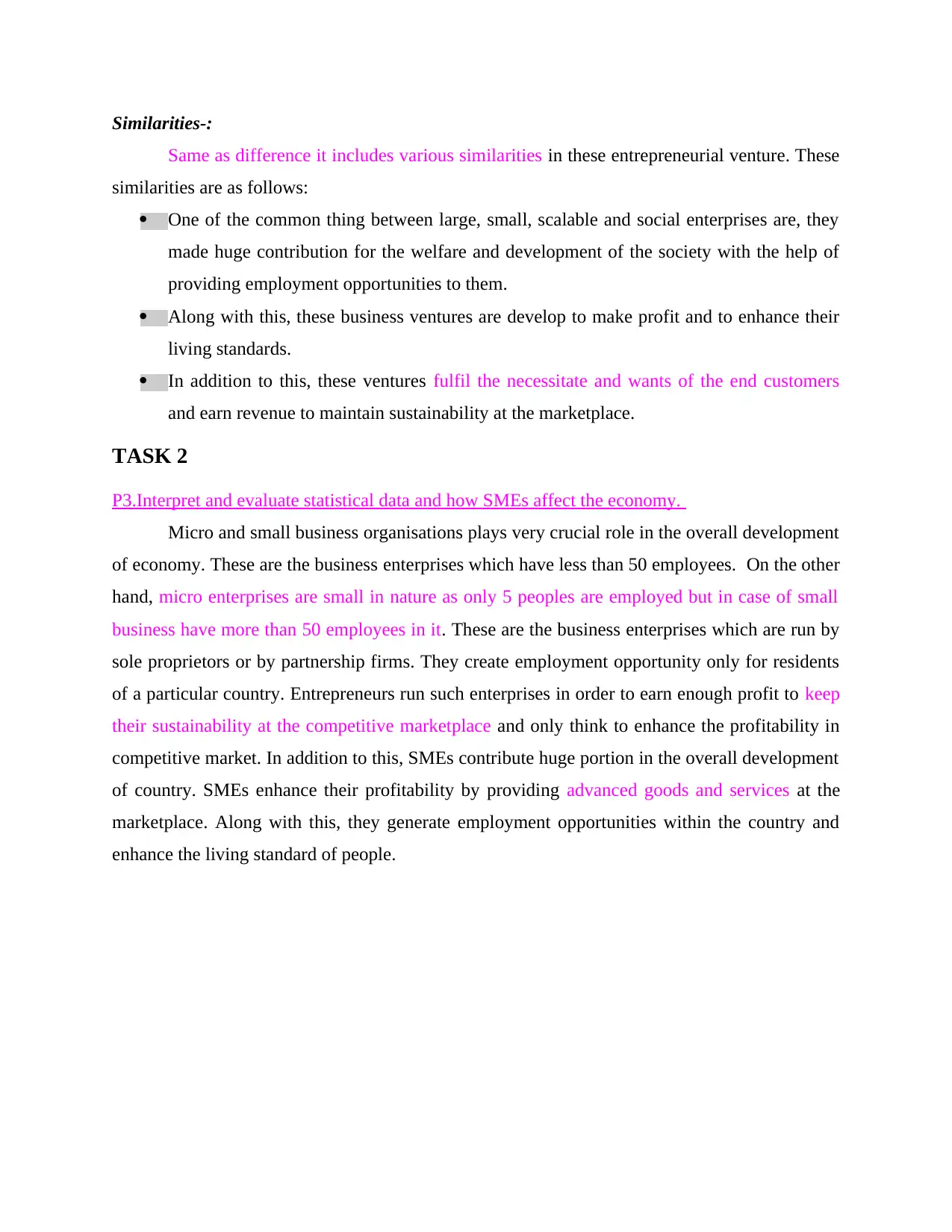
Similarities-:
Same as difference it includes various similarities in these entrepreneurial venture. These
similarities are as follows:
One of the common thing between large, small, scalable and social enterprises are, they
made huge contribution for the welfare and development of the society with the help of
providing employment opportunities to them.
Along with this, these business ventures are develop to make profit and to enhance their
living standards.
In addition to this, these ventures fulfil the necessitate and wants of the end customers
and earn revenue to maintain sustainability at the marketplace.
TASK 2
P3.Interpret and evaluate statistical data and how SMEs affect the economy.
Micro and small business organisations plays very crucial role in the overall development
of economy. These are the business enterprises which have less than 50 employees. On the other
hand, micro enterprises are small in nature as only 5 peoples are employed but in case of small
business have more than 50 employees in it. These are the business enterprises which are run by
sole proprietors or by partnership firms. They create employment opportunity only for residents
of a particular country. Entrepreneurs run such enterprises in order to earn enough profit to keep
their sustainability at the competitive marketplace and only think to enhance the profitability in
competitive market. In addition to this, SMEs contribute huge portion in the overall development
of country. SMEs enhance their profitability by providing advanced goods and services at the
marketplace. Along with this, they generate employment opportunities within the country and
enhance the living standard of people.
Same as difference it includes various similarities in these entrepreneurial venture. These
similarities are as follows:
One of the common thing between large, small, scalable and social enterprises are, they
made huge contribution for the welfare and development of the society with the help of
providing employment opportunities to them.
Along with this, these business ventures are develop to make profit and to enhance their
living standards.
In addition to this, these ventures fulfil the necessitate and wants of the end customers
and earn revenue to maintain sustainability at the marketplace.
TASK 2
P3.Interpret and evaluate statistical data and how SMEs affect the economy.
Micro and small business organisations plays very crucial role in the overall development
of economy. These are the business enterprises which have less than 50 employees. On the other
hand, micro enterprises are small in nature as only 5 peoples are employed but in case of small
business have more than 50 employees in it. These are the business enterprises which are run by
sole proprietors or by partnership firms. They create employment opportunity only for residents
of a particular country. Entrepreneurs run such enterprises in order to earn enough profit to keep
their sustainability at the competitive marketplace and only think to enhance the profitability in
competitive market. In addition to this, SMEs contribute huge portion in the overall development
of country. SMEs enhance their profitability by providing advanced goods and services at the
marketplace. Along with this, they generate employment opportunities within the country and
enhance the living standard of people.
Secure Best Marks with AI Grader
Need help grading? Try our AI Grader for instant feedback on your assignments.
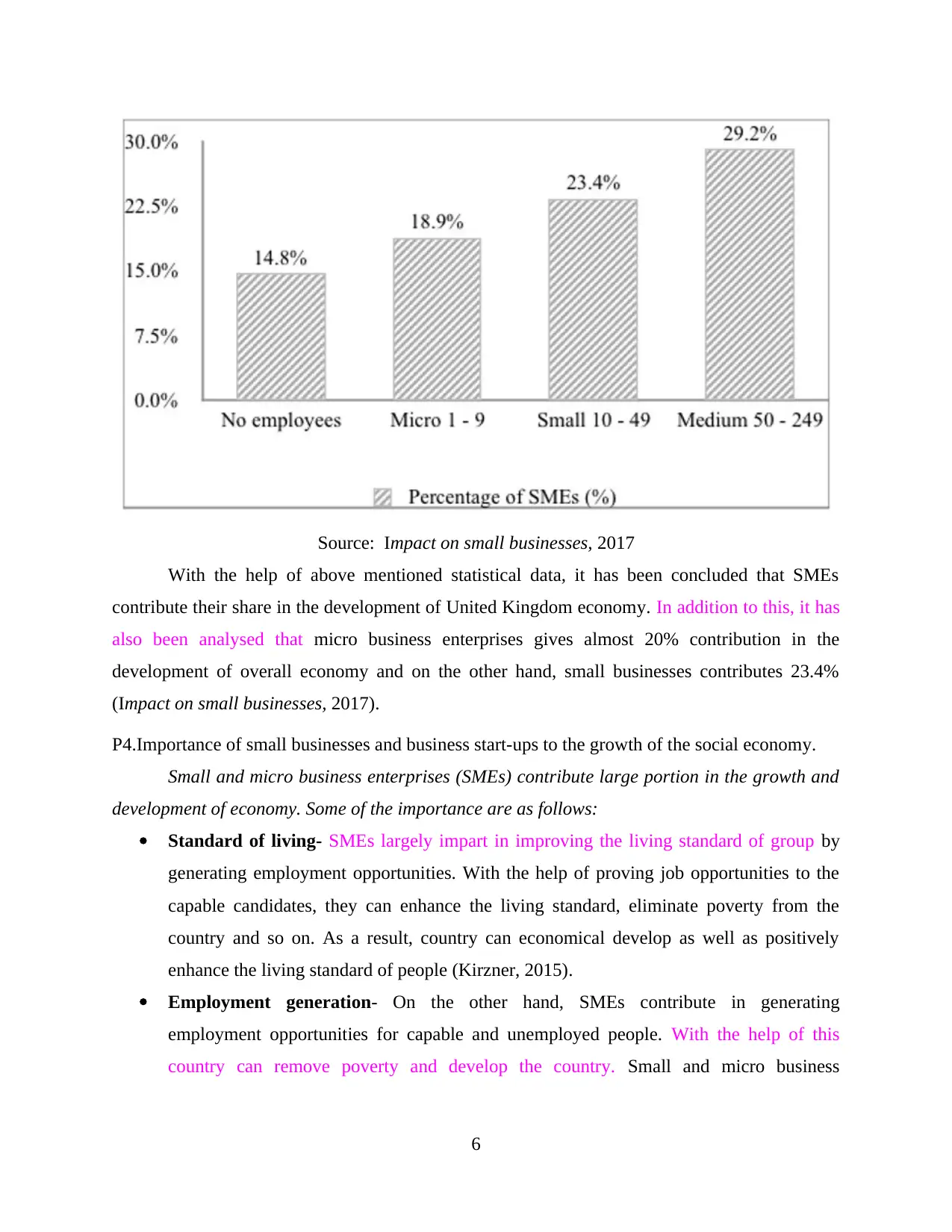
Source: Impact on small businesses, 2017
With the help of above mentioned statistical data, it has been concluded that SMEs
contribute their share in the development of United Kingdom economy. In addition to this, it has
also been analysed that micro business enterprises gives almost 20% contribution in the
development of overall economy and on the other hand, small businesses contributes 23.4%
(Impact on small businesses, 2017).
P4.Importance of small businesses and business start-ups to the growth of the social economy.
Small and micro business enterprises (SMEs) contribute large portion in the growth and
development of economy. Some of the importance are as follows:
Standard of living- SMEs largely impart in improving the living standard of group by
generating employment opportunities. With the help of proving job opportunities to the
capable candidates, they can enhance the living standard, eliminate poverty from the
country and so on. As a result, country can economical develop as well as positively
enhance the living standard of people (Kirzner, 2015).
Employment generation- On the other hand, SMEs contribute in generating
employment opportunities for capable and unemployed people. With the help of this
country can remove poverty and develop the country. Small and micro business
6
With the help of above mentioned statistical data, it has been concluded that SMEs
contribute their share in the development of United Kingdom economy. In addition to this, it has
also been analysed that micro business enterprises gives almost 20% contribution in the
development of overall economy and on the other hand, small businesses contributes 23.4%
(Impact on small businesses, 2017).
P4.Importance of small businesses and business start-ups to the growth of the social economy.
Small and micro business enterprises (SMEs) contribute large portion in the growth and
development of economy. Some of the importance are as follows:
Standard of living- SMEs largely impart in improving the living standard of group by
generating employment opportunities. With the help of proving job opportunities to the
capable candidates, they can enhance the living standard, eliminate poverty from the
country and so on. As a result, country can economical develop as well as positively
enhance the living standard of people (Kirzner, 2015).
Employment generation- On the other hand, SMEs contribute in generating
employment opportunities for capable and unemployed people. With the help of this
country can remove poverty and develop the country. Small and micro business
6
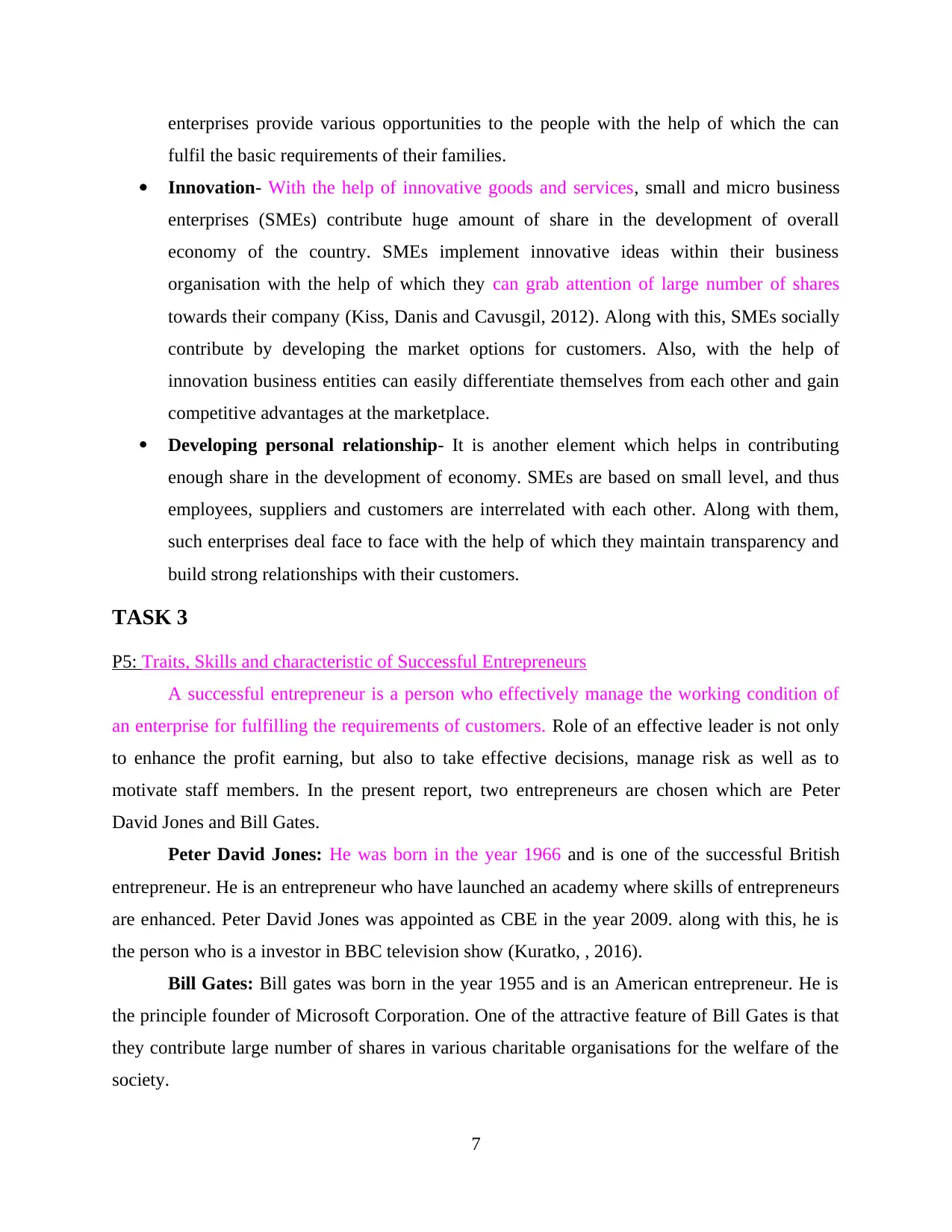
enterprises provide various opportunities to the people with the help of which the can
fulfil the basic requirements of their families.
Innovation- With the help of innovative goods and services, small and micro business
enterprises (SMEs) contribute huge amount of share in the development of overall
economy of the country. SMEs implement innovative ideas within their business
organisation with the help of which they can grab attention of large number of shares
towards their company (Kiss, Danis and Cavusgil, 2012). Along with this, SMEs socially
contribute by developing the market options for customers. Also, with the help of
innovation business entities can easily differentiate themselves from each other and gain
competitive advantages at the marketplace.
Developing personal relationship- It is another element which helps in contributing
enough share in the development of economy. SMEs are based on small level, and thus
employees, suppliers and customers are interrelated with each other. Along with them,
such enterprises deal face to face with the help of which they maintain transparency and
build strong relationships with their customers.
TASK 3
P5: Traits, Skills and characteristic of Successful Entrepreneurs
A successful entrepreneur is a person who effectively manage the working condition of
an enterprise for fulfilling the requirements of customers. Role of an effective leader is not only
to enhance the profit earning, but also to take effective decisions, manage risk as well as to
motivate staff members. In the present report, two entrepreneurs are chosen which are Peter
David Jones and Bill Gates.
Peter David Jones: He was born in the year 1966 and is one of the successful British
entrepreneur. He is an entrepreneur who have launched an academy where skills of entrepreneurs
are enhanced. Peter David Jones was appointed as CBE in the year 2009. along with this, he is
the person who is a investor in BBC television show (Kuratko, , 2016).
Bill Gates: Bill gates was born in the year 1955 and is an American entrepreneur. He is
the principle founder of Microsoft Corporation. One of the attractive feature of Bill Gates is that
they contribute large number of shares in various charitable organisations for the welfare of the
society.
7
fulfil the basic requirements of their families.
Innovation- With the help of innovative goods and services, small and micro business
enterprises (SMEs) contribute huge amount of share in the development of overall
economy of the country. SMEs implement innovative ideas within their business
organisation with the help of which they can grab attention of large number of shares
towards their company (Kiss, Danis and Cavusgil, 2012). Along with this, SMEs socially
contribute by developing the market options for customers. Also, with the help of
innovation business entities can easily differentiate themselves from each other and gain
competitive advantages at the marketplace.
Developing personal relationship- It is another element which helps in contributing
enough share in the development of economy. SMEs are based on small level, and thus
employees, suppliers and customers are interrelated with each other. Along with them,
such enterprises deal face to face with the help of which they maintain transparency and
build strong relationships with their customers.
TASK 3
P5: Traits, Skills and characteristic of Successful Entrepreneurs
A successful entrepreneur is a person who effectively manage the working condition of
an enterprise for fulfilling the requirements of customers. Role of an effective leader is not only
to enhance the profit earning, but also to take effective decisions, manage risk as well as to
motivate staff members. In the present report, two entrepreneurs are chosen which are Peter
David Jones and Bill Gates.
Peter David Jones: He was born in the year 1966 and is one of the successful British
entrepreneur. He is an entrepreneur who have launched an academy where skills of entrepreneurs
are enhanced. Peter David Jones was appointed as CBE in the year 2009. along with this, he is
the person who is a investor in BBC television show (Kuratko, , 2016).
Bill Gates: Bill gates was born in the year 1955 and is an American entrepreneur. He is
the principle founder of Microsoft Corporation. One of the attractive feature of Bill Gates is that
they contribute large number of shares in various charitable organisations for the welfare of the
society.
7

Traits and skills observed in Peter David Jones and Bill Gates are:
Peter David Jones Bill Gates
Skills
Motivator: Peter Jones is a
motivator as he always
motivates all his team members
in order to enhance the growth
of the company (Chrisman and
et. al., 2012).
Communication: Peter Jones
thinks the key element to be
successful is effective
communication with their
employees and managers.
Focused: Bill Gates is the
entrepreneur who is highly
focused in his work and create best
and effective products.
Mindfulness: Bill Gates is an
intelligent person who knows how
to take criticism in a positive
manner.
Traits
Innovation: Peter Jones
innovate new and create
products.
Feedback Approach: according
to Peter Jones each and every
entrepreneur should take
feedback and work according to
the requirements and
suggestion.
Innovation: one of the common
trait between Peter Jones and Bill
Gates is their creativity. Both of
them offer services and products in
a creative manner.
Experimentalist: Bill gates highly
believes in doing experiments and
create new and innovate things.
Characteris
tics
Team-Player: Peter Jones have
the quality of a team player, as
he take his team together in
order to achieve organisational
goal in an effective manner.
Leadership: Bill Gates is one of
the successful entrepreneur and he
have the capability to know how to
achieve goals effectively (Decker
and et. al., 2014).
Difference between entrepreneurs and business managers:
8
Peter David Jones Bill Gates
Skills
Motivator: Peter Jones is a
motivator as he always
motivates all his team members
in order to enhance the growth
of the company (Chrisman and
et. al., 2012).
Communication: Peter Jones
thinks the key element to be
successful is effective
communication with their
employees and managers.
Focused: Bill Gates is the
entrepreneur who is highly
focused in his work and create best
and effective products.
Mindfulness: Bill Gates is an
intelligent person who knows how
to take criticism in a positive
manner.
Traits
Innovation: Peter Jones
innovate new and create
products.
Feedback Approach: according
to Peter Jones each and every
entrepreneur should take
feedback and work according to
the requirements and
suggestion.
Innovation: one of the common
trait between Peter Jones and Bill
Gates is their creativity. Both of
them offer services and products in
a creative manner.
Experimentalist: Bill gates highly
believes in doing experiments and
create new and innovate things.
Characteris
tics
Team-Player: Peter Jones have
the quality of a team player, as
he take his team together in
order to achieve organisational
goal in an effective manner.
Leadership: Bill Gates is one of
the successful entrepreneur and he
have the capability to know how to
achieve goals effectively (Decker
and et. al., 2014).
Difference between entrepreneurs and business managers:
8
Paraphrase This Document
Need a fresh take? Get an instant paraphrase of this document with our AI Paraphraser
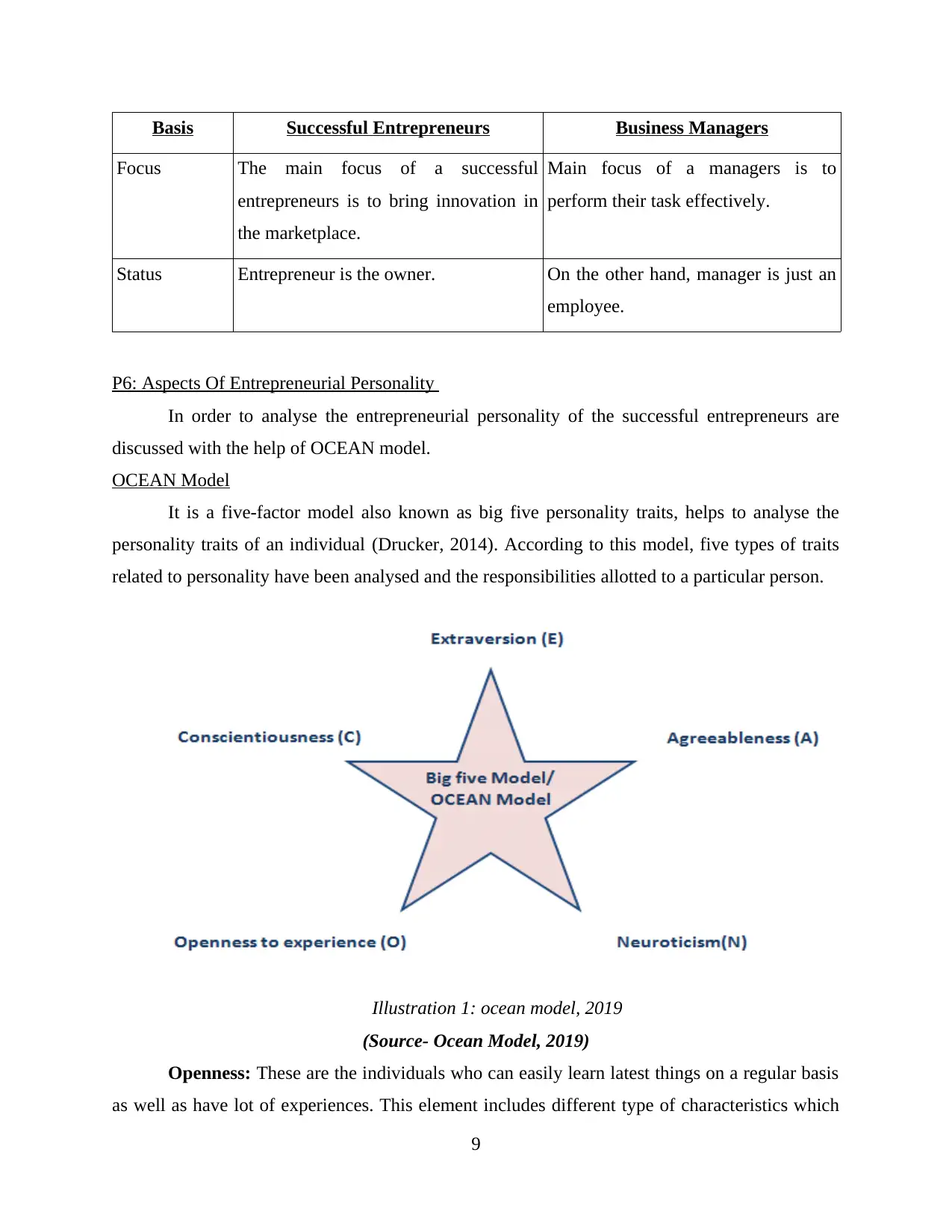
Basis Successful Entrepreneurs Business Managers
Focus The main focus of a successful
entrepreneurs is to bring innovation in
the marketplace.
Main focus of a managers is to
perform their task effectively.
Status Entrepreneur is the owner. On the other hand, manager is just an
employee.
P6: Aspects Of Entrepreneurial Personality
In order to analyse the entrepreneurial personality of the successful entrepreneurs are
discussed with the help of OCEAN model.
OCEAN Model
It is a five-factor model also known as big five personality traits, helps to analyse the
personality traits of an individual (Drucker, 2014). According to this model, five types of traits
related to personality have been analysed and the responsibilities allotted to a particular person.
(Source- Ocean Model, 2019)
Openness: These are the individuals who can easily learn latest things on a regular basis
as well as have lot of experiences. This element includes different type of characteristics which
9
Illustration 1: ocean model, 2019
Focus The main focus of a successful
entrepreneurs is to bring innovation in
the marketplace.
Main focus of a managers is to
perform their task effectively.
Status Entrepreneur is the owner. On the other hand, manager is just an
employee.
P6: Aspects Of Entrepreneurial Personality
In order to analyse the entrepreneurial personality of the successful entrepreneurs are
discussed with the help of OCEAN model.
OCEAN Model
It is a five-factor model also known as big five personality traits, helps to analyse the
personality traits of an individual (Drucker, 2014). According to this model, five types of traits
related to personality have been analysed and the responsibilities allotted to a particular person.
(Source- Ocean Model, 2019)
Openness: These are the individuals who can easily learn latest things on a regular basis
as well as have lot of experiences. This element includes different type of characteristics which
9
Illustration 1: ocean model, 2019
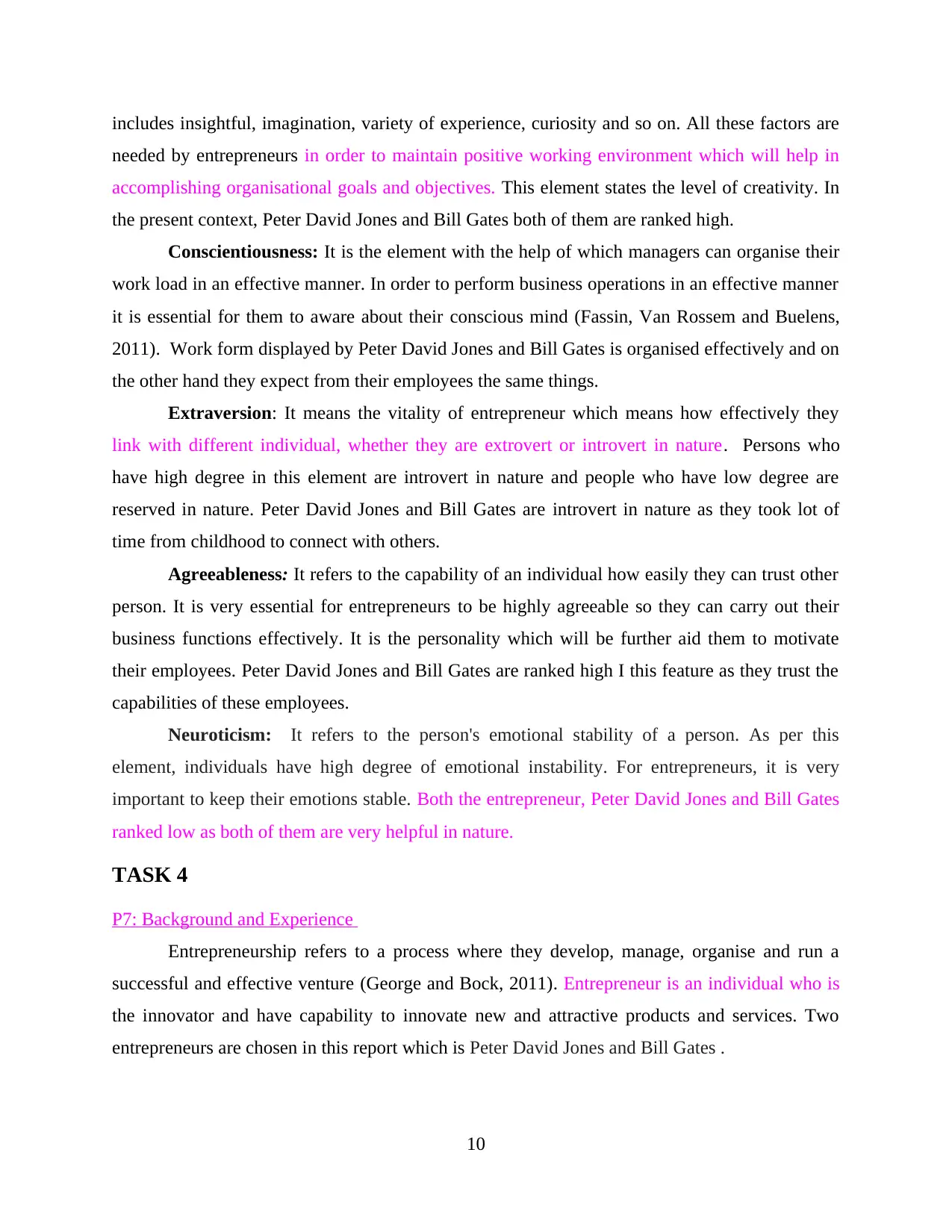
includes insightful, imagination, variety of experience, curiosity and so on. All these factors are
needed by entrepreneurs in order to maintain positive working environment which will help in
accomplishing organisational goals and objectives. This element states the level of creativity. In
the present context, Peter David Jones and Bill Gates both of them are ranked high.
Conscientiousness: It is the element with the help of which managers can organise their
work load in an effective manner. In order to perform business operations in an effective manner
it is essential for them to aware about their conscious mind (Fassin, Van Rossem and Buelens,
2011). Work form displayed by Peter David Jones and Bill Gates is organised effectively and on
the other hand they expect from their employees the same things.
Extraversion: It means the vitality of entrepreneur which means how effectively they
link with different individual, whether they are extrovert or introvert in nature. Persons who
have high degree in this element are introvert in nature and people who have low degree are
reserved in nature. Peter David Jones and Bill Gates are introvert in nature as they took lot of
time from childhood to connect with others.
Agreeableness: It refers to the capability of an individual how easily they can trust other
person. It is very essential for entrepreneurs to be highly agreeable so they can carry out their
business functions effectively. It is the personality which will be further aid them to motivate
their employees. Peter David Jones and Bill Gates are ranked high I this feature as they trust the
capabilities of these employees.
Neuroticism: It refers to the person's emotional stability of a person. As per this
element, individuals have high degree of emotional instability. For entrepreneurs, it is very
important to keep their emotions stable. Both the entrepreneur, Peter David Jones and Bill Gates
ranked low as both of them are very helpful in nature.
TASK 4
P7: Background and Experience
Entrepreneurship refers to a process where they develop, manage, organise and run a
successful and effective venture (George and Bock, 2011). Entrepreneur is an individual who is
the innovator and have capability to innovate new and attractive products and services. Two
entrepreneurs are chosen in this report which is Peter David Jones and Bill Gates .
10
needed by entrepreneurs in order to maintain positive working environment which will help in
accomplishing organisational goals and objectives. This element states the level of creativity. In
the present context, Peter David Jones and Bill Gates both of them are ranked high.
Conscientiousness: It is the element with the help of which managers can organise their
work load in an effective manner. In order to perform business operations in an effective manner
it is essential for them to aware about their conscious mind (Fassin, Van Rossem and Buelens,
2011). Work form displayed by Peter David Jones and Bill Gates is organised effectively and on
the other hand they expect from their employees the same things.
Extraversion: It means the vitality of entrepreneur which means how effectively they
link with different individual, whether they are extrovert or introvert in nature. Persons who
have high degree in this element are introvert in nature and people who have low degree are
reserved in nature. Peter David Jones and Bill Gates are introvert in nature as they took lot of
time from childhood to connect with others.
Agreeableness: It refers to the capability of an individual how easily they can trust other
person. It is very essential for entrepreneurs to be highly agreeable so they can carry out their
business functions effectively. It is the personality which will be further aid them to motivate
their employees. Peter David Jones and Bill Gates are ranked high I this feature as they trust the
capabilities of these employees.
Neuroticism: It refers to the person's emotional stability of a person. As per this
element, individuals have high degree of emotional instability. For entrepreneurs, it is very
important to keep their emotions stable. Both the entrepreneur, Peter David Jones and Bill Gates
ranked low as both of them are very helpful in nature.
TASK 4
P7: Background and Experience
Entrepreneurship refers to a process where they develop, manage, organise and run a
successful and effective venture (George and Bock, 2011). Entrepreneur is an individual who is
the innovator and have capability to innovate new and attractive products and services. Two
entrepreneurs are chosen in this report which is Peter David Jones and Bill Gates .
10
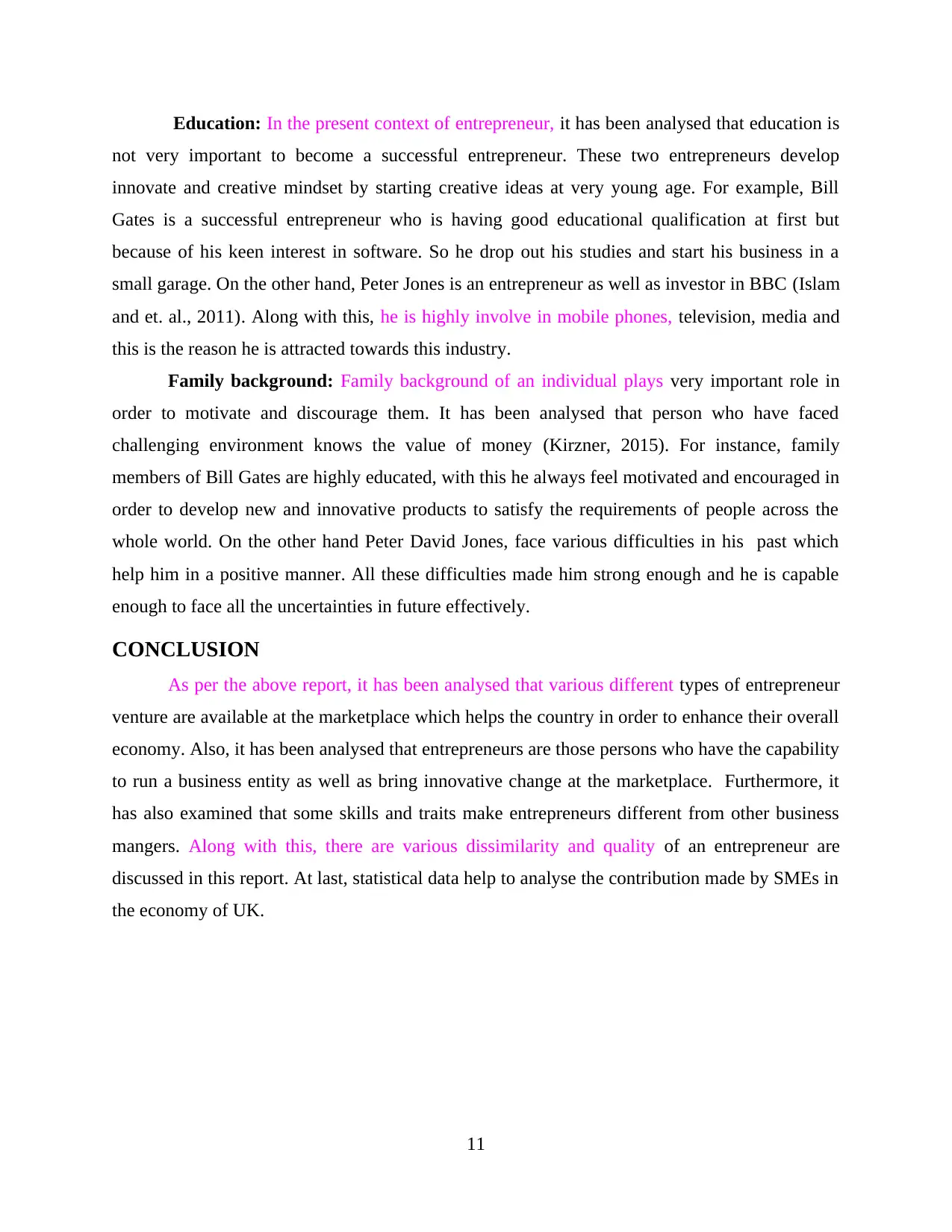
Education: In the present context of entrepreneur, it has been analysed that education is
not very important to become a successful entrepreneur. These two entrepreneurs develop
innovate and creative mindset by starting creative ideas at very young age. For example, Bill
Gates is a successful entrepreneur who is having good educational qualification at first but
because of his keen interest in software. So he drop out his studies and start his business in a
small garage. On the other hand, Peter Jones is an entrepreneur as well as investor in BBC (Islam
and et. al., 2011). Along with this, he is highly involve in mobile phones, television, media and
this is the reason he is attracted towards this industry.
Family background: Family background of an individual plays very important role in
order to motivate and discourage them. It has been analysed that person who have faced
challenging environment knows the value of money (Kirzner, 2015). For instance, family
members of Bill Gates are highly educated, with this he always feel motivated and encouraged in
order to develop new and innovative products to satisfy the requirements of people across the
whole world. On the other hand Peter David Jones, face various difficulties in his past which
help him in a positive manner. All these difficulties made him strong enough and he is capable
enough to face all the uncertainties in future effectively.
CONCLUSION
As per the above report, it has been analysed that various different types of entrepreneur
venture are available at the marketplace which helps the country in order to enhance their overall
economy. Also, it has been analysed that entrepreneurs are those persons who have the capability
to run a business entity as well as bring innovative change at the marketplace. Furthermore, it
has also examined that some skills and traits make entrepreneurs different from other business
mangers. Along with this, there are various dissimilarity and quality of an entrepreneur are
discussed in this report. At last, statistical data help to analyse the contribution made by SMEs in
the economy of UK.
11
not very important to become a successful entrepreneur. These two entrepreneurs develop
innovate and creative mindset by starting creative ideas at very young age. For example, Bill
Gates is a successful entrepreneur who is having good educational qualification at first but
because of his keen interest in software. So he drop out his studies and start his business in a
small garage. On the other hand, Peter Jones is an entrepreneur as well as investor in BBC (Islam
and et. al., 2011). Along with this, he is highly involve in mobile phones, television, media and
this is the reason he is attracted towards this industry.
Family background: Family background of an individual plays very important role in
order to motivate and discourage them. It has been analysed that person who have faced
challenging environment knows the value of money (Kirzner, 2015). For instance, family
members of Bill Gates are highly educated, with this he always feel motivated and encouraged in
order to develop new and innovative products to satisfy the requirements of people across the
whole world. On the other hand Peter David Jones, face various difficulties in his past which
help him in a positive manner. All these difficulties made him strong enough and he is capable
enough to face all the uncertainties in future effectively.
CONCLUSION
As per the above report, it has been analysed that various different types of entrepreneur
venture are available at the marketplace which helps the country in order to enhance their overall
economy. Also, it has been analysed that entrepreneurs are those persons who have the capability
to run a business entity as well as bring innovative change at the marketplace. Furthermore, it
has also examined that some skills and traits make entrepreneurs different from other business
mangers. Along with this, there are various dissimilarity and quality of an entrepreneur are
discussed in this report. At last, statistical data help to analyse the contribution made by SMEs in
the economy of UK.
11
Secure Best Marks with AI Grader
Need help grading? Try our AI Grader for instant feedback on your assignments.
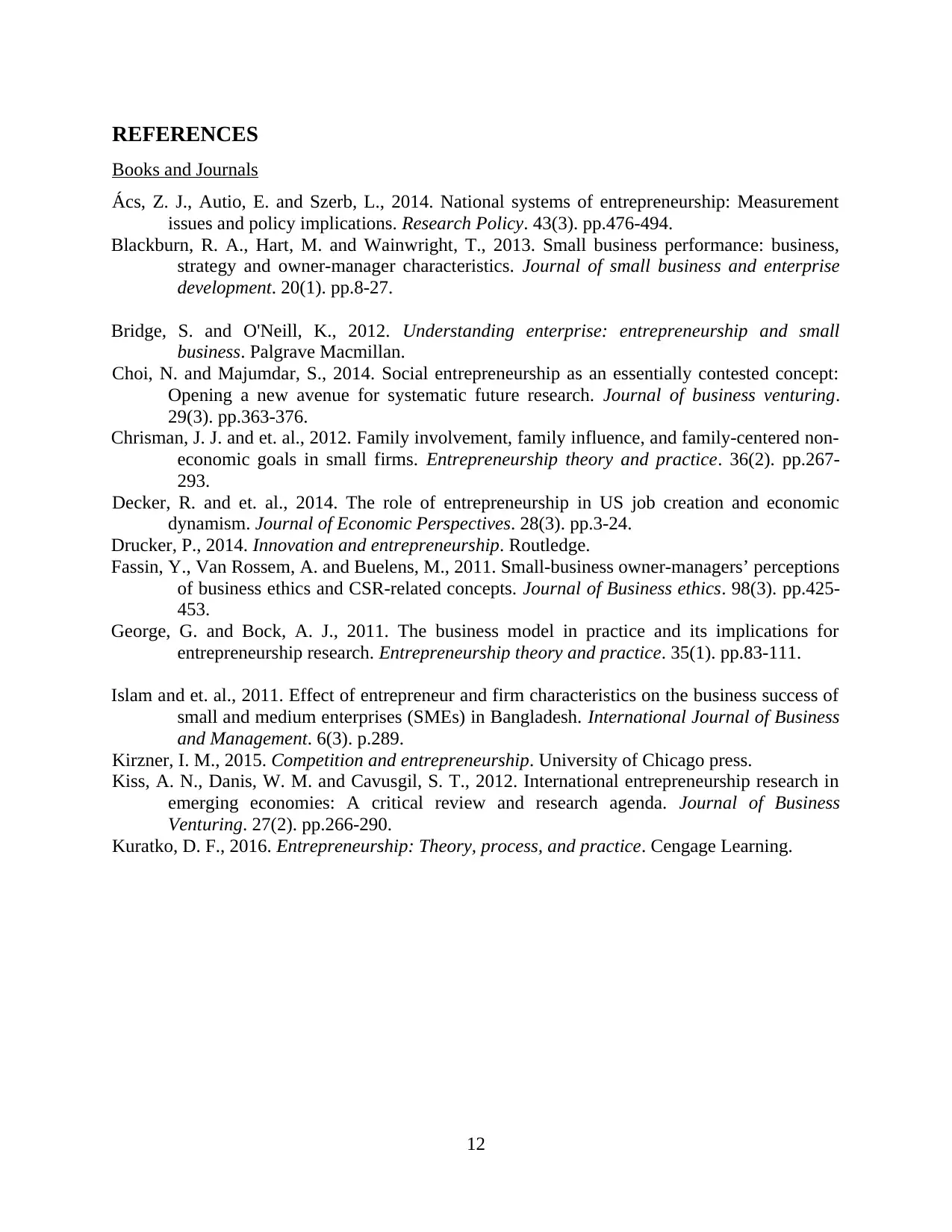
REFERENCES
Books and Journals
Ács, Z. J., Autio, E. and Szerb, L., 2014. National systems of entrepreneurship: Measurement
issues and policy implications. Research Policy. 43(3). pp.476-494.
Blackburn, R. A., Hart, M. and Wainwright, T., 2013. Small business performance: business,
strategy and owner-manager characteristics. Journal of small business and enterprise
development. 20(1). pp.8-27.
Bridge, S. and O'Neill, K., 2012. Understanding enterprise: entrepreneurship and small
business. Palgrave Macmillan.
Choi, N. and Majumdar, S., 2014. Social entrepreneurship as an essentially contested concept:
Opening a new avenue for systematic future research. Journal of business venturing.
29(3). pp.363-376.
Chrisman, J. J. and et. al., 2012. Family involvement, family influence, and family‐centered non‐
economic goals in small firms. Entrepreneurship theory and practice. 36(2). pp.267-
293.
Decker, R. and et. al., 2014. The role of entrepreneurship in US job creation and economic
dynamism. Journal of Economic Perspectives. 28(3). pp.3-24.
Drucker, P., 2014. Innovation and entrepreneurship. Routledge.
Fassin, Y., Van Rossem, A. and Buelens, M., 2011. Small-business owner-managers’ perceptions
of business ethics and CSR-related concepts. Journal of Business ethics. 98(3). pp.425-
453.
George, G. and Bock, A. J., 2011. The business model in practice and its implications for
entrepreneurship research. Entrepreneurship theory and practice. 35(1). pp.83-111.
Islam and et. al., 2011. Effect of entrepreneur and firm characteristics on the business success of
small and medium enterprises (SMEs) in Bangladesh. International Journal of Business
and Management. 6(3). p.289.
Kirzner, I. M., 2015. Competition and entrepreneurship. University of Chicago press.
Kiss, A. N., Danis, W. M. and Cavusgil, S. T., 2012. International entrepreneurship research in
emerging economies: A critical review and research agenda. Journal of Business
Venturing. 27(2). pp.266-290.
Kuratko, D. F., 2016. Entrepreneurship: Theory, process, and practice. Cengage Learning.
12
Books and Journals
Ács, Z. J., Autio, E. and Szerb, L., 2014. National systems of entrepreneurship: Measurement
issues and policy implications. Research Policy. 43(3). pp.476-494.
Blackburn, R. A., Hart, M. and Wainwright, T., 2013. Small business performance: business,
strategy and owner-manager characteristics. Journal of small business and enterprise
development. 20(1). pp.8-27.
Bridge, S. and O'Neill, K., 2012. Understanding enterprise: entrepreneurship and small
business. Palgrave Macmillan.
Choi, N. and Majumdar, S., 2014. Social entrepreneurship as an essentially contested concept:
Opening a new avenue for systematic future research. Journal of business venturing.
29(3). pp.363-376.
Chrisman, J. J. and et. al., 2012. Family involvement, family influence, and family‐centered non‐
economic goals in small firms. Entrepreneurship theory and practice. 36(2). pp.267-
293.
Decker, R. and et. al., 2014. The role of entrepreneurship in US job creation and economic
dynamism. Journal of Economic Perspectives. 28(3). pp.3-24.
Drucker, P., 2014. Innovation and entrepreneurship. Routledge.
Fassin, Y., Van Rossem, A. and Buelens, M., 2011. Small-business owner-managers’ perceptions
of business ethics and CSR-related concepts. Journal of Business ethics. 98(3). pp.425-
453.
George, G. and Bock, A. J., 2011. The business model in practice and its implications for
entrepreneurship research. Entrepreneurship theory and practice. 35(1). pp.83-111.
Islam and et. al., 2011. Effect of entrepreneur and firm characteristics on the business success of
small and medium enterprises (SMEs) in Bangladesh. International Journal of Business
and Management. 6(3). p.289.
Kirzner, I. M., 2015. Competition and entrepreneurship. University of Chicago press.
Kiss, A. N., Danis, W. M. and Cavusgil, S. T., 2012. International entrepreneurship research in
emerging economies: A critical review and research agenda. Journal of Business
Venturing. 27(2). pp.266-290.
Kuratko, D. F., 2016. Entrepreneurship: Theory, process, and practice. Cengage Learning.
12

13
1 out of 15
Related Documents
Your All-in-One AI-Powered Toolkit for Academic Success.
+13062052269
info@desklib.com
Available 24*7 on WhatsApp / Email
![[object Object]](/_next/static/media/star-bottom.7253800d.svg)
Unlock your academic potential
© 2024 | Zucol Services PVT LTD | All rights reserved.





